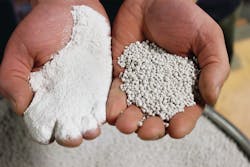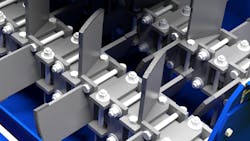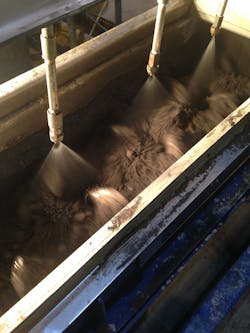Promoting and preventing agglomeration in the mixing process
Industrial mixers serve essential processing goals throughout various industries, preparing materials for subsequent processing, ensuring product quality is met and producing the chemicals our world relies on.
The nature of industrial mixers is such that in addition to mixing, they can also facilitate agglomeration (granulation) — particle size enlargement that can bring a host of benefits to powdered bulk solids, including improved transportation and handling characteristics, enhanced performance and more.
But agglomeration is not always desirable when it comes to mixing — many industrial process settings and products require material to be in the form of fines or very small granules. Whether agglomeration is desirable or not, mixer operators often struggle, either to prevent agglomeration during mixing or to promote it and reach the desired granule size or quality.
Many operators take this challenge as a necessary evil, not realizing that their process could function better with some adjustment. As such, the ability to manipulate and control granule formation, be it in fostering it or discouraging it, is an essential skill for mixer operators in the bulk solids processing space.
Challenges of agglomeration mismanagement
Whether or not agglomeration is desirable, producers require that their products consistently meet the necessary quality standards. This translates to careful control over the production process, including granule formation and growth (or prevention of such occurrence).
When agglomeration occurs unintentionally, downstream processing equipment may not be equipped to properly process the material. This is often the case when mixing will be followed by a drying step; a dryer intended to dry fines or small agglomerates will likely not be able to sufficiently dry larger agglomerates, which could require reprocessing, or, if not caught, product caking or spoilage during storage or transportation.
Likewise, material that is meant to be granulated but is not would likely be blown out of the dryer through the exhaust system, because the dryer’s air velocity was designed for granules, not fines.
In any of these scenarios, the result is typically lost or spoiled product, higher processing costs, longer production times, reduced efficiency, lower production rates, inferior product and ineffective downstream processing, among many other probable issues.
By giving mixer operators the knowledge and tools they need to control agglomeration, these problems can be minimized and often avoided altogether.
Understanding agglomeration
Contrary to popular belief, granule formation is not the result of a particular type of equipment, but rather the characteristics of the material at a given time and how the environment acts on it. When agglomeration occurs in a mixing vessel, granule formation is the result of a type of non-pressure agglomeration known as agitation agglomeration, also referred to as wet granulation, pelletizing or tumble-growth agglomeration.
Mixers are a prime example of agglomeration’s ability to occur anywhere because they are often combining a blend of liquid and dry solids with agitation. In fact, under the right conditions, any mixer is capable of producing agglomerates.
In order to control agglomeration in their favor during the mixing process, operators must recognize and understand the principles behind this type of agglomeration.
Factors that influence agglomeration
As the most influential factors in agglomerate formation, the following parameters can be manipulated during processing to enhance or deter agglomeration in an industrial mixing system. Some of these factors are adjustable in real time, while others require more extensive adjustments, such as a change in suppliers or a modification to the process.
Moisture content
Moisture content is a critical influencer in both promoting and preventing agglomeration. This is true of any moisture in the process, whether it exists naturally in the feedstock, is added through the inclusion of a liquid binder or comes from the environment (operators trying to prevent agglomeration may find that it occurs more readily on humid days, due to material absorbing moisture from the air).
A general rule of thumb follows that the more moisture present, the more likely it is that agglomeration will occur, though this is only true up to a point; if too much moisture is added, the material will become mud-like and will not properly agglomerate.
Operators can therefore manage agglomeration by paying close attention to the amount of moisture in their process. If undesirable agglomeration is occurring, they must take steps to reduce the amount of moisture, such as reducing the moisture content of the feedstock or lowering the amount of liquid binder being added. Adjusting the amount of binder is not always feasible, as this can throw off product formulation, so, depending on the product, this approach may or may not be an option.
In reducing moisture content, an alternative option may be to utilize a technique known as back-mixing, in which dried/finished product is mixed in with the feedstock to reduce the overall moisture content. Dispersion agents may also sometimes be utilized to prevent the mixture from forming agglomerates.
Similarly, in promoting agglomeration or trying to accelerate agglomerate growth, operators can take measures to increase the amount of moisture in the process.
It is important to note, however, that none of the influential factors described here — moisture content included — operates in isolation. The occurrence or lack of agglomeration is often the result of several interconnected factors. In addition to the amount of moisture, for example, other factors can be experimented with in order to encourage or deter agglomeration in a given process setting, including spray rate, location(s) and even nozzle type.
Motion (pin/paddle arrangement)
Convective mixers utilize a physical agitator or rotational tumbling motion to not only mix material but also to help convey the material through the mixer. In many cases, this motion can be modified or adjusted, allowing operators to encourage or discourage granule formation.
This is particularly true of pin mixers and pugmill (paddle) mixers; when working with pugmill mixers, paddles can be removed and reversed to alter the mixing action. Paddles with different angles, as well as double paddles, can also be installed. Similarly, in pin mixers, pin arrangement can be adjusted to change how particles move within the unit as well, encouraging or discouraging granule formation.
Depending on the type of mixer employed, mixer operators may be able to make adjustments that promote or prevent agglomeration. Some materials, though seemingly dry, will release their moisture when agitated, requiring careful control over both the moisture content and motion (as well as speed in many cases) to manage granule formation.
Speed
The speed at which the mixer moves also plays an important role in managing granule formation. If motion is too slow, agglomerates may not form; too fast and they may form too quickly, which could then allow them to grow to a size that is larger than desired or may even pulverize on reaching a certain size (due to the particle-to-particle and particle-to-mixer collision).
The optimal range of speed for a given material is specific to the material’s characteristics, as well as the type of mixer used. In a pin mixer, for example, faster rotor speeds are associated with smaller granules, while slower speeds produce larger granules. Many operators find, however, that they have some wiggle room in speeding up or slowing down the mixer speed enough to get the results they are looking for.
Retention time
Retention time — also known as residence time — is the amount of time the material is in the mixer. In general, the longer the retention time, the more likely it will be that agglomerates will form or increase in size.
While this depends on the type of mixer, in many horizontal mixers the disparate components will first come together to form a homogeneous mixture, at which point they will begin to agglomerate. If they continue to remain in the mixer, the agglomerates will continue to collect layers, or coalesce, growing in size.
As such, and depending on the operational goals, the operator may experiment with adjusting retention time to either promote or discourage agglomeration.
Temperature
Temperature is not always a contributing factor to agglomeration, but it certainly can be when working with elevated temperatures or high speeds.
When agglomerating a hot material, for example, there is potential for the high temperature to flash off moisture on entry into the mixer. This could require the addition of extra moisture in the form of the liquid binder to account for the lost moisture if moisture is no longer sufficient for granule formation to occur.
In other cases, material may become hot due to the mechanical friction occurring in the mixer. Depending on the material, this could create steam in the mixer, which could have a negative or positive effect on agglomeration.
Material characteristics
It is important to recognize that how well a material does or does not agglomerate is also highly dependent on the specific qualities and characteristics of the material. All materials, and even the same material from different sources, respond uniquely to agglomeration; some materials, such as gypsum, agglomerate readily, while others, such as sand, are highly resistant to agglomeration. A given material may fall anywhere on this spectrum between these two extremes.
Depending on the material and the goal of the mixing device, special accommodations may be required to reach product goals. Further complicating matters, materials may change or form new compounds when mixed, which can create a new set of challenges.
As such, it is important for operators to have a thorough working knowledge of the specific material or compound they are processing, as its unique characteristics will often help to guide the path toward issue resolution in times of upset or inadequate processing.
Mixer testing
The complex and interdependent nature of promoting or preventing agglomeration in a mixer often necessitates a testing regime to determine the most efficient route to achieving the desired results.
Dedicated testing facilities can offer a range of capabilities at different scales, anywhere from batch to pilot scale and even toll processing. Depending on the process goals, mixer testing typically centers around identifying and refining the production parameters necessary to most efficiently reach the intended product quality. This includes evaluating parameters such as:
- Feedstock composition and response to agitation agglomeration
- Feedstock particle size distribution
- Feedstock moisture content
- Binder concentration, spray rate, location and nozzle type
- Mixer speed and retention time
- Pin/paddle arrangement
- Mixer type
In addition to testing, process audits and operator training are also valuable tools in optimizing a mixing process.
Those intending to agglomerate their material but unable to reach the desired size with their existing mixer may also find through testing that the addition of a disc pelletizer or rotary drum granulator would help them to achieve the desired results. When added to mixing equipment, these types of agglomeration equipment take the “seed pellets” formed in the mixer and provide a place for additional coalescence to occur, allowing operators to achieve the desired size product.
Conclusion
Unintended or inadequate agglomeration presents a host of issues in any process setting. The ability to prevent or promote granule formation in a mixing process is highly dependent on the operator’s understanding of the material’s unique characteristics and the principles behind agitation (tumble-growth) agglomeration. This includes moisture content, motion, speed, retention time and temperature.
Batch- and pilot-scale testing, along with operator training and process audits, depending on the unique situation, are therefore critical tools for plant managers looking to optimize the efficiency of their mixing process.
Chris Kozicki is a process sales engineer specializing in tumble-growth agglomeration and has been with FEECO for over 30 years. Kozicki is an active member of the agglomeration community and former president of the Institute for Briquetting and Agglomeration (IBA).
FEECO International
About the Author
Chris Kozicki
Process Sales Engineer at FEECO
Chris Kozicki is a Process Sales Engineer specializing in tumble-growth agglomeration and has been with FEECO for over 30 years. Chris is an active member of the agglomeration community and former president of the Institute for Briquetting and Agglomeration (IBA).




